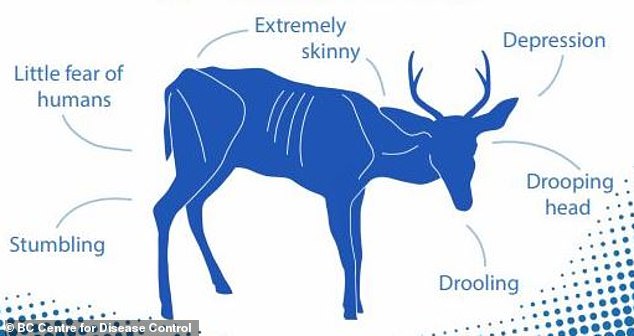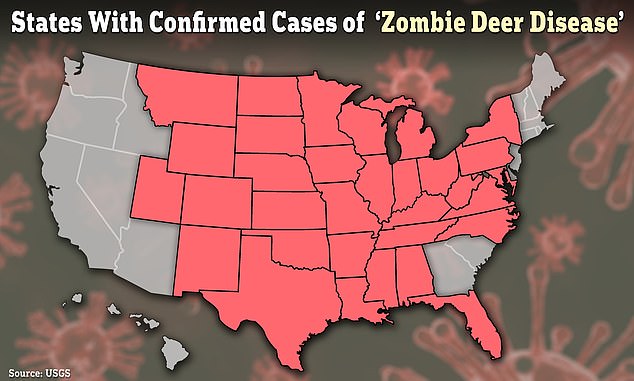- Indiana is the 33rd state to report a case of chronic wasting disease in deer
- There is no prevention or cure for this brain-damaging condition.
- READ MORE: Two hunters become first in US to die from ‘ZOMBIE DEER disease’
A deadly “zombie deer disease” continues to spread throughout the United States and has now been detected in Indiana, making it present in 33 states.
The Indiana Department of Natural Resources confirmed that chronic wasting disease (CWD), which is believed to jump from deer to humans, has been detected for the first time in an Indiana white-tailed deer.
It comes weeks after it was revealed that two deer hunters had died from a disease they possibly contracted from eating infected deer meat.
Chronic wasting disease, or cachexia, is a contagious neurological condition that kills virtually all animals it infects. It has been nicknamed “zombie deer disease” because it causes parts of the brain to slowly deteriorate to a spongy consistency and causes behavioral changes, starvation and, eventually, death.
It is spreading rapidly among southern, midwestern and northeastern U.S. states, raising concerns among experts about possible human contagion.
At least 33 states in the United States and parts of Canada have seen reports of a virus called “zombie deer disease” that could potentially be transmitted to humans.
The CDC has said no cases of CWD infection have been reported in people, but some animal studies suggest the infection poses a risk to some types of nonhuman primates, such as monkeys, that eat meat from animals infected with CWD. chronicle.
However, Texas researchers believe they have discovered two cases of a similar neurological condition in hunters who ate venison and contracted it because the deer they had eaten were infected with chronic wasting disease.
Experts have been warning for years that this nearly 100 percent fatal condition, which leaves deer confused, drooling and unafraid of humans, could jump from animals to people.
CWD is caused by proteins in the body that do not fold into the correct shape called prions. After infection, prions travel throughout the central nervous system and leave prion deposits in brain tissues and organs.
It belongs to the class of prion diseases, which also includes mad cow disease.
Chronic wasting disease was first discovered in 1967 in Colorado in captive deer, but has now been found in animals in at least 33 states, four Canadian provinces and four other foreign countries.
Recent studies have shown that CWD prions have the ability to infect and multiply in human cells under laboratory conditions, raising concerns of spillover.
It is believed that humans can contract the disease by eating infected venison or by contact with contaminated soil and water.
It can take more than a year for an infected animal to develop symptoms, which can include drastic weight loss, stumbling, and listlessness.

Chronic wasting disease has been nicknamed “zombie deer disease” because it causes parts of the brain to slowly deteriorate to a spongy consistency.
The exact route of transmission is not fully understood, but the disease is believed to be transmitted from animal to animal by eating forage or water contaminated with infected feces or by exposure to carcasses.
Direct contact, including saliva, blood, urine, and even antler velvet during the annual molt, can also contribute to the transmission of the pathogen.
Any deer that dies on a farm must be tested for chronic wasting disease, and because the disease is so contagious, if one animal tests positive, the entire herd is considered infected.
A report published in the journal Neurology earlier this month theorized that the disease may have already jumped species to two hunters who died in 2022 after eating contaminated venison.
Researchers believe that two men who died in an unspecified state from Creutzfeldt-Jakob disease (CJD), a brain-weakening prion disease that has been compared to mad cow disease, contracted the condition after eating meat from deer infected with chronic wasting disease.

